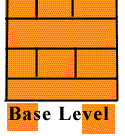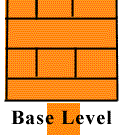

Purpose: The game Jenga has long captivated audiences of party go'ers since its origin. For those who do not know the game, Jenga is a building of 18 stories, with each stories containing 3 side by side wood blocks. The purpose of the game, is to remove one of the three blocks from any story and placing it on the top of the structure, without knocking anything down. The purpose of this experiment will focus on the bottom layer, to determine whether pulling the sides off the bottom will enable higher buildings or will pulling the middle piece.
![]()
Hypothesis: The hypothesis of this experiment is that a Jenga structure which uses the side pieces as the base will be more stable and therefore allow for higher levels then a structure which uses only the middle piece as the base. The logic behind this hypothesis is that a Jenga structure which uses only the base will be more susceptible to forces perpendicular to the base and fall more readily in those directions.
![]()
Equipment: One Jenga set, pen and paper.
![]()
Procedure: The first step is to set up the Jenga set, once done, pull the middle block from the base (see fig. 1), and play the game according to the rules. Keep track of stories completed, and when the structure crumbles record the total of completed stories. Repeat this process, however, this time, pull the two sides away, leaving the middle piece (see fig. 2), record results, repeat experiment, and compare.


| Type of base | Average Number of stories per attempt | Highest number of stories | Lowest number of stories |
| Sides |
|
|
|
| Middle |
|
|
|
![]()
Conclusion: Contrary to the hypothesis, higher
stories were completed when only the middle was left as the base. Though
the reason currently baffles Scientific AmeriKen, it could be said that
it really doesn't matter whether the sides or the middle is pulled since
it relies on many other factors which occur as the game proceeds. However,
this result does support another hypothesis, which is that pulling middle
pieces is for wusses.